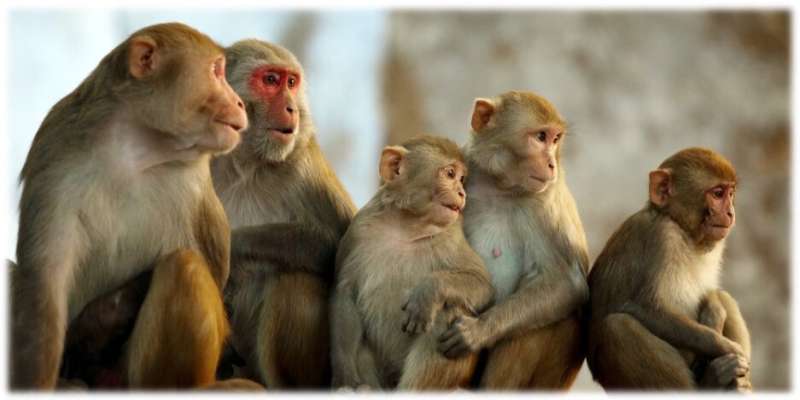Like humans, rhesus monkeys have complex cognitive abilities and display stable and pronounced individual differences in social functioning, making them a promising model to better understand the biological and behavioral mechanisms underlying social impairments. Credit: Kathy West
New research builds upon growing evidence demonstrating the importance of rhesus macaque monkeys (Macaca mulatta) as a model for the core social impairments observed in autism spectrum disorder (ASD).
ASD is an early onset neurodevelopmental condition characterized by persistent social communication and interaction impairments. Despite its prevalence and societal cost, its basic disease mechanisms remain poorly understood in part due to the overreliance on rodent models, which lack the complex social and cognitive skills critical to modeling behavioral symptoms relevant to human ASD.
Like humans, rhesus monkeys have complex cognitive abilities and display stable and pronounced individual differences in social functioning, making them a promising model to better understand the biological and behavioral mechanisms underlying social impairments.
"Rhesus monkey sociality is stable across time and linked to variation in the initiation but not receipt of prosocial behavior," a study by assistant professor Catherine F. Talbot, Ph.D., in the School of Psychology at Florida Tech and researchers from Stanford University and University of California, Davis's California National Primate Research Center, found that several aspects of social functioning differed between monkeys that were classified as low-social compared to monkeys classified as high-social.
Analyzing three years of data from 95 male rhesus monkeys housed at the California National Primate Research Center in large, outdoor social groups in semi-naturalistic habitats, the team first classified monkeys based on their natural social behavior. For instance, they looked at whether the monkeys were participating in activities such as grooming, which is a behavior that facilitates social bonding in non-human primates, or if they were in proximity to or in contact with other individuals, or if they were just hanging out by themselves with no one else around.
Monkeys that spent the most time alone were classified as low-social, whereas monkeys that spent the least time alone were classified as high-social. Next, the researchers evaluated differences between the social communication profiles of these two groups of monkeys. The team found that high-social monkeys initiate more pro-social behavior, which encompasses behaviors like sitting in contact with others and grooming, compared to low-social monkeys. However, there was no difference between how often low-social monkeys and high-social monkeys received pro-social behavior.
"This suggests that there's this underlying social motivation factor, that we're seeing a higher social motivation as high-social monkeys, which doesn't sound like rocket science, but it does support the social motivation hypothesis of ASD and lend insight into how this might be impacted by underlying biology," Talbot said.
"There are multiple theories or ideas about what drives social impairments observed in autism and one of them is that individuals with ASD have lower social motivation." This hypothesis suggests that people with ASD tend to have deficits in social reward processing, which causes diminished social initiation and difficulty in fostering and maintaining social bonds. In other words, social interactions are not inherently rewarding.
The team also found that there was no difference in threat behavior between low-social and high-social monkeys, either in the initiation or receipt of threats. That was contrary to their hypothesis, where they figured that if low-social monkeys are not communicating effectively with their peers they would be more likely to get bullied and receive traumatic injuries, something they have found in previous research. The findings of the current study better characterize this naturally occurring, low-social phenotype and can help researchers gain mechanistic insight into social motivation deficits observed in people with ASD.
"There really hasn't been much work looking at rhesus macaques as an ASD model," Talbot said. "What we're modeling are naturally occurring social deficits. So, in humans, autism spectrum disorder is just that—a spectrum—and you see these traits that are distributed throughout the entire human population, not just the clinical population. People who may not be classified as being on the spectrum will also exhibit some these traits."
Individuals with ASD may also experience deficits in other socio-cognitive skills like theory of mind, which is understanding that one's own personal beliefs and knowledge are different from others. Following eye gaze and understanding what another person is looking at is another component one component of theory of mind. An impaired ability to follow eye gaze is often one of the first behavioral signs to emerge in children with ASD.
The team is also working on research looking at the underlying biology of low-social and high-social monkeys and how this might relate to their performance on other social cognitive tasks, including how well the monkeys follow the eye gaze of their peers, how well they interact with their peers, how well they identify faces and how that compares to their performance in the non-social domain, like how well they identify objects.
The work is published in the American Journal of Primatology.
More information: Catherine F. Talbot et al, Rhesus monkey sociality is stable across time and linked to variation in the initiation but not receipt of prosocial behavior, American Journal of Primatology (2022). DOI: 10.1002/ajp.23442
Journal information: American Journal of Primatology
Provided by Florida Institute of Technology
























